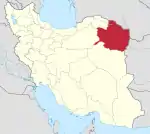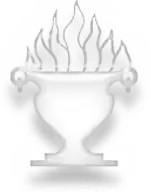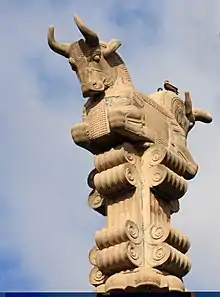Kashmar
Kashmar (Persian: کاشمر, also Romanized as Kāshmar; formerly کشمر Keshmar, ترشیز Torshīz or سلطانآباد Soltanabad)[2] is a city and the capital of Kashmar County, in Razavi Khorasan Province, Iran. Kashmar is located near the river Sish Taraz in the western part of the province, and 217 kilometres (135 mi) south of the province's capital Mashhad, in Iran, from east to Bardaskan, west to Torbat-e Heydarieh, north to Nishapur, south to Gonabad. Until two centuries ago, this city was named Torshiz (ترشیز). At the 2006 census, its population was 81,527, in 21,947 families.[3]
Kashmar
کاشمر | |
|---|---|
City | |
     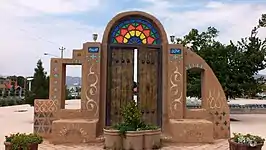 From up: Tomb of Hassan Modares, 2 photos Jameh Mosque of Kashmar, Imamzadeh Hamzeh, Kashmar, Imamzadeh Seyed Morteza, Old wooden door Symbol Kashmar. Kashmar Tourist Places | |
.svg.png.webp) Location of Kashmar County in Razavi Khorasan province | |
 Kashmar Location of Kashmar County in Razavi Khorasan province | |
| Coordinates: 35°14′18″N 58°27′56″E | |
| Country | |
| Province | Razavi Khorasan |
| County | Kashmar |
| Bakhsh | Central |
| Elevation | 1,063 m (3,488 ft) |
| Population (2016 Census) | |
| • Urban | 102,282[1] |
| Time zone | UTC+3:30 (IRST) |
| • Summer (DST) | UTC+4:30 (IRDT) |
| Area code(s) | (+98) 051 552 |
| Kashmar at GEOnet Names Server | |
History
The history of this city goes back to Zarathustra and the Sarv-e Abarkuh, the Cypress of Kashmar (see also the oldest tree). It seems that this is the only miracle of this prophet that there are many legends about it.[4]
In 520 AH, the city was looted by the Seljuk Sultan Sanjar and later became an important center of the Ismaili sect. After their defeat, the city flourished again, but was destroyed by Timur Gurkhani. The historical monuments of this region date back to the 7th and 8th centuries AH.[5]
Parthians
The Parthians, and before them, the Seleucids, attached great importance to the religion of Zoroastrianism, and paid great attention to Cypress of Kashmar, which was considered a relic of Zoroaster. The regions of Kashmar and Nishapur were considered fertile areas of Iran during the Parthian Empire.[6]
Sasanians
According to the Paikuli inscription, during the Sasanian Empire, Kashmar was part of Greater Khorasan, and the Sasanians worked hard to revive the ancient religion. It still remains a few kilometers above the ancient city of Kashmar in the castle complex of Atashgah. The ruins of this fort are now located 5-6 km northwest of Kashmar and are considered Sasanian monuments.[6]
Historical legends
Kashmar is a city with ancient history and many legendary stories Among the historical legends are about the Cypress of Kashmar.[7]
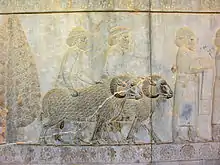

Cypress of Kashmar
The Cypress of Kashmar is a mythical cypress tree of legendary beauty and gargantuan dimensions. It is said to have sprung from a branch brought by Zoroaster from Paradise and to have stood in today's Kashmar in northeastern Iran and to have been planted by Zoroaster in honor of the conversion of King Vishtaspa to Zoroastrianism. According to the Iranian physicist and historian Zakariya al-Qazwini King Vishtaspa had been a patron of Zoroaster who planted the tree himself. In his ʿAjā'ib al-makhlūqāt wa gharā'ib al-mawjūdāt, he further describes how the Al-Mutawakkil in 247 AH (861 AD) caused the mighty cypress to be felled, and then transported it across Iran, to be used for beams in his new palace at Samarra. Before, he wanted the tree to be reconstructed before his eyes. This was done in spite of protests by the Iranians, who offered a very high sum of money to save the tree. Al-Mutawakkil never saw the cypress, because he was murdered by a Turkish soldier (possibly in the employ of his son) on the night when it arrived on the banks of the Tigris.[8][9]
Fire Temple of Kashmar
Kashmar Fire Temple was the first Zoroastrian fire temple built by Vishtaspa at the request of Zoroaster in Kashmar. In a part of Ferdowsi's Shahnameh, the story of finding Zarathustra and accepting Vishtaspa's religion is regulated that after accepting Zoroastrian religion, Vishtaspa sends priests all over the universe And Azar enters the fire temples (domes) and the first of them is Adur Burzen-Mihr who founded in Kashmar and planted a cypress tree in front of the fire temple and made it a symbol of accepting the Bahi religion And he sent priests all over the world, and commanded all the famous men and women to come to that place of worship.[10]
Religion
The city is fourth pilgrimage city in Iran and it is the second most pilgrimage city after Mashhad in Razavi Khorasan Province.[11]
Education
At present, Kashmar has five higher education centers, including Payame Noor University of Kashmar, Islamic Azad University of Kashmar, Jihad University of Kashmar, Kashmar Higher Education Center and the School of Nursing. According to the statistics of the above institute, 3,794,420 students are studying in the country's universities, of which about 3,500 are Kashmir students.[12]

Souvenirs
The city is a major producer of raisins and has about 40 types of grapes. It is also internationally recognized for exporting saffron and handmade Persian rugs. The main souvenirs of this city are the Kashmar carpet, raisins, grapes, saffron, dried fruits, and the confectionary sohan.[13]
Kashmar carpet
Kashmar carpet is a regional Persian carpet named after its origin, the city of Kashmar, that is produced throughout the Kashmar County. The carpets are handmade and are often available with landscape and hunting designs.[14][15][16] The history of carpet weaving in Kashmar dates back to 150 years and the contemporary art of carpet weaving dates back to 1920. However, between 1260 and 1280, mass production of carpets was recorded by historians. The first master weaver in the Kashmar region was Mohammad Kermani, who, despite his last name, was not from Kerman, but people say he was born in a village called Forutqeh near Kashmar. According to historians, the master weaver brought the knowledge of carpet weaving from Kerman province, and his first work was probably commissioned by Saeed Hossein Sajjadi, a native and resident of Forutqeh and a famous carpet manufacturer.[17]
Historical sites, ancient artifacts and tourism
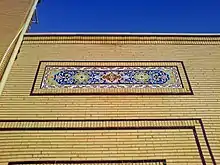
Tomb of Hassan Modarres
The Tomb of Sayyid Hassan Modarres is the burial site of Sayyid Hassan Modares, former prime minister of Iran. It was built in 1937 in Kashmar, Iran, as opposed to using the former tomb of Kashmar in the vast gardens of Kashmar. The tomb building consists of a central dome, four dock and a dome made of turquoise, in the style of Islamic architecture and the Safavid dynasty. Seyed Hassan Modares lived during the Pahlavi dynasty and was from the Sadat of Tabatabai. He was a political constitutionalist.[18][19][20]
Imamzadeh Seyed Morteza
Imamzadeh Seyed Morteza is related to the Qajar dynasty and is located in Razavi Khorasan Province, Kashmar. Massive trees, waterfalls and swimming pools add to the attractions of this place, and on the other hand, a good number of living rooms provide a good base for traveling to this place, as well as the many shops and dining halls.[21][22]
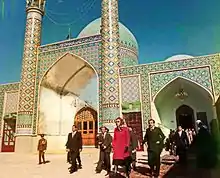
Imamzadeh Hamzeh, Kashmar
Imamzadeh Hamzah, Kashmar the oldest mosque in Kashmar, includes the tomb of Hamza al-Hamza ibn Musa al-Kadhim, the garden and the public cemetery, and is as an Imamzadeh.[23][24]
Jameh Mosque of Kashmar
Jameh Mosque of Kashmar, the place where Jumu'ah is performed, was built in Kashmar in 1791 by Fath-Ali Shah Qajar. This Mosque is opposite the Amin al-tojar Caravansarai.[25][26]
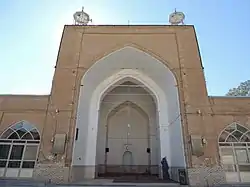
Jameh Mosque of Khalilabad
Jameh Mosque of Khalilabad is a Pahlavi dynasty period mosque in Khalilabad, Razavi Khorasan Province.[27][28]
Haji Jalal Mosque
Haji Jalal Mosque is a Qajar dynasty period mosque in Kashmar, Razavi Khorasan Province.[29]
Kohneh Zendeh Jan Castle
Kohneh Zendeh Jan Castle is a Castle related to the 1st millennium and is located in the Kashmar County, Zendeh Jan village.[30]
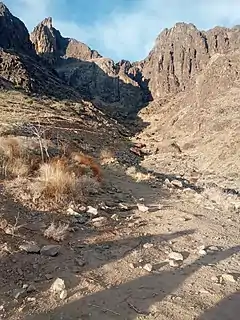
Atashgah castle
Atashghah castle is a castle in the city of Kashmar, and is one of the attractions of Kashmar. This castle was built by the Sasanian government and it was famous in ancient times.[31][32]
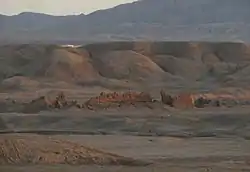
Rig castle
Rig castle is a Castle related to the Seljuq dynasty and is located in the Kashmar County, Quzhd village.[33][34]
Amin al-tojar Caravansarai
Amin al-tojar Caravansarai is a caravanserai related to the Qajar dynasty and is located in Kashmar. This Caravansarai is opposite the Jameh Mosque of Kashmar.[35][36]
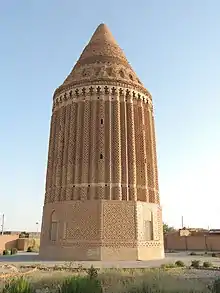
Aliabad Tower
This tower is located in Aliabad-e Keshmar, 42 km from Kashmar city. This tower is built on the castle and its minaret is similar to the tower and its facade is made of decorative brick inlay. This dome is 18 meters. Tall with an octagonal interior. This tower is in the historical records.[37][38]

Firuzabad Tower
This minaret is made of brick and there are inscriptions on it called "Kufic" which dates back to the late 7th century AH. Although the minaret is made of simple brick - the bricks are laid in a zigzag pattern to enhance its beauty. Inside the minaret, the remains of a staircase can be seen and holes are inscribed on the minaret. Currently, this minaret is 18 meters high.[39][40]
Nameq Village
Nameq is located in a hilly area and many mountains surround the village. It has many historical sites, for example, the tomb of the great Gnostic Sheikh Abol Hassan (father of Sheikh Ahmad-e Jami) is located 500 meters. From the village in a green plain. In addition, there are the remains of an ancient castle, pre-Islamic and post-Islamic cemeteries, a citadel, mosques and other beautiful pieces of architecture.[41][42]
Shahi Dam
Shahi Dam is built the about 7000 thousand years ago and is located in Kariz, Kuhsorkh County.[43][44]

Seyyed Bagher Ab anbar
The Seyed Bagher Ab anbar is a historical Ab anbar of Qajar dynasty that is located in city center of Bardaskan, in Ghaem Avenue. This Ab anbar was added to the list of National Monuments of Iran As the 11034st monument.[45][46]
Baghdasht Peak
Baghdasht mountain range, the largest peak of which is 2500 meters above sea level, is part of the Rivash heights and is located near the village of Kariz, 25 km northwest of Kashmar.[47]
Haj Sultan Theological School
This school is one of the buildings of the Qajar era, which has a central courtyard and is surrounded on four sides by two-story rooms and two north and south porches.[48][49]
Gabar Hesar castle
Gabar Hesar Castle is a Castle related to the second century AH and is located in the Kuhsorkh County.[50]
Ultralight Airport Kashmar
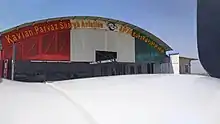
Ultralight Airport Kashmar
Ultralight Airport Kashmar is an airport in the city of Kashmar in Iran, which is located on a 17-hectare land in the southwest of Khorasan Razavi province, about 240 kilometers from the city of Mashhad; And with one runway, it has the capacity to accept all light and ultralight aircraft.[51]
Notable people

Manouchehr Eghbal
Manuchehr Eqbal (Persian: منوچهر اقبال; 13 October 1909 – 25 November 1977) was an Iranian royalist politician. He held office as the Prime Minister of Iran from 1957 to 1960. He served as the minister of health in Ahmad Ghavam's cabinet, minister of culture in Abdolhosein Hazhir's cabinet, minister of transportation in RajabAli Mansur's cabinet, and interior minister in Mohammad Sa'ed's cabinet. He also served as the governor of East Azarbaijan province.[52] In 1957, he became prime minister, replacing Hussein Ala.[53][54] Eghbal continued as prime minister until fall 1960 and was replaced by Sharif Emami.[55] Until his death, he served as a top executive in Iran's National Oil Company. He was also one of the close aides to the Shah.[56]
Fateme Ekhtesari
Fateme Ekhtesari, also Fatemeh Ekhtesari, (born 1986) is an Iranian poet.[57][58] Ekhtesari lived in Karaj and she writes in Persian.[59] In 2013, she appeared at the poetry festival in Gothenburg (Göteborgs poesifestival). After she arrived back in Iran she was imprisoned and later released on bail. Her verdict came in 2015 when she was sentenced to 99 lashes and 11.5 years imprisonment for crimes against the Iranian government, for immoral behaviour and blasphemy.[60]
.jpg.webp)
Alireza Faghani
Alireza Faghani (Persian: عليرضا فغانى, born 21 March 1978) is an Iranian international football referee who has been officiating in the Persian Gulf Pro League for several seasons and has been on the FIFA list since 2008. Faghani has refereed important matches such as the 2014 AFC Champions League Final, the 2015 AFC Asian Cup Final, the 2015 FIFA Club World Cup Final , the 2016 Olympic football final match. He has refereed matches in the 2017 Liga 1 , 2017 FIFA Confederations Cup, 2018 FIFA World Cup in Russia and the 2019 AFC Asian Cup. Alireza migrated to Australia in September 2019.
Fereydoun Jeyrani
Fereydoun Jeyrani (Persian: فریدون جیرانی; born in 1951, Bardaskan) is an Iranian film director, screenwriter, and Television presenter. He was the director, producer and host of haft (Seven) (an Iranian television series about Iranian Cinema) until 2012. Along with his unconventional performance in Haft, he is best known for directing Red, The Season Salad, Water and Fire, Pink and I am a Mother.[61][62] Jeyrani TV Host Haft First series.

Mohammad Khazaee
Mohammad Khazaee (Persian: محمد خزاعی, born 12 April 1953 in Kashmar, Iran)[63] is the former Ambassador of Iran to the United Nations. He presented his credentials to the United Nations Secretary-General Ban Ki-moon in July 2007.[63] He was elected as Vice President of the United Nations General Assembly on 14 September 2011.
Ali Rahmani
Ali Rahmani (علی رحمانی) was born in Kashmar (25 May 1967). He was the first managing director of Tehran Stock Exchange.[64][65] He is an associate professor at Alzahra University.
Iran Teymourtash
Iran Teymourtāsh (Persian: ایران تیمورتاش; 1914–1991), the eldest daughter of Abdolhossein Teymourtāsh, is considered a pioneer among women activists in 20th-century Iran. Her father's position as the second most powerful political personality in Iran, from 1925 to 1932, afforded Iran Teymourtāsh the opportunity to play a prominent role in that country's women's affairs early in life.
Military operations
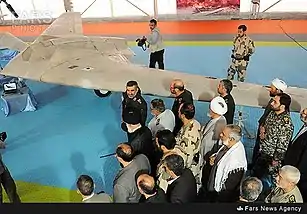
Iran–U.S. RQ-170 incident
On 5 December 2011, an American Lockheed Martin RQ-170 Sentinel unmanned aerial vehicle (UAV) was captured by Iranian forces near the city of Kashmar in northeastern Iran. The Iranian government announced that the UAV was brought down by its cyberwarfare unit which commandeered the aircraft and safely landed it, after initial reports from Western news sources disputedly claimed that it had been "shot down".[66] The United States government initially denied the claims but later President Obama acknowledged that the downed aircraft was a US drone.[67][68] Iran filed a complaint to the UN over the airspace violation. Obama asked Iran to return the drone. Iran is said to have produced drones based on the captured RQ-170.
Kashmar Great Earthquake
1903
The Kashmar Earthquake occurred on September 25, 1903, at 1:20 AM UTC time in Iran. Its magnitude is 6.5 on the Richter scale. The U.S. Geological Survey[69] also estimated the quake at 35.2°N 58.2°E E and its magnitude was 6.5 on the Richter scale..
The death toll from the quake was about 200.
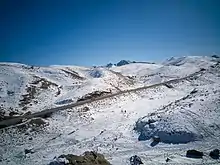
Geographical location
Kashmar County with two central district and Farah Dasht, and to the center of Kashmar city has occupied an area of about 3390 square kilometers of Khorasan Razavi province With the County of Kuhsorkh. This city is adjacent to Khalilabad from the west, to Nishapur, Sabzevar and Bardaskan from the north and northwest, to Torbat-e Heydarieh from the east and northeast, and to the Feyzabad from the south and southwest. Kashmar city has two mountainous areas of the Rivash in the north and Fagan Bajestan heights in the south and desert and arid regions in the west and south and fertile plains in the suburbs and its towns. In terms of climate, it can be said that Kashmar has all three types of climate because the northern parts of the city are mountainous and cold, the central regions are temperate and the southern regions are arid and semi-arid due to its proximity to the Lut desert.[70][71]
Climate
Köppen-Geiger climate classification system classifies its climate as cold semi-arid (BSk) with short, cool winters and long, hot summers.[72]
| Climate data for Kashmar | |||||||||||||
|---|---|---|---|---|---|---|---|---|---|---|---|---|---|
| Month | Jan | Feb | Mar | Apr | May | Jun | Jul | Aug | Sep | Oct | Nov | Dec | Year |
| Average high °C (°F) | 9.5 (49.1) |
12.4 (54.3) |
16.8 (62.2) |
22.3 (72.1) |
29.2 (84.6) |
34 (93) |
35.7 (96.3) |
36.2 (97.2) |
31.9 (89.4) |
25.9 (78.6) |
18.1 (64.6) |
12 (54) |
23.7 (74.6) |
| Daily mean °C (°F) | 3.3 (37.9) |
6.1 (43.0) |
10.3 (50.5) |
15.3 (59.5) |
21.2 (70.2) |
25.6 (78.1) |
27.9 (82.2) |
27.4 (81.3) |
22.9 (73.2) |
17 (63) |
10.3 (50.5) |
5.3 (41.5) |
16.1 (60.9) |
| Average low °C (°F) | −2.9 (26.8) |
−0.1 (31.8) |
3.9 (39.0) |
8.4 (47.1) |
13.3 (55.9) |
17.3 (63.1) |
20.2 (68.4) |
18.6 (65.5) |
13.9 (57.0) |
8.2 (46.8) |
2.6 (36.7) |
−1.4 (29.5) |
8.5 (47.3) |
| Average precipitation mm (inches) | 29 (1.1) |
24 (0.9) |
31 (1.2) |
37 (1.5) |
17 (0.7) |
2 (0.1) |
0 (0) |
0 (0) |
0 (0) |
6 (0.2) |
13 (0.5) |
19 (0.7) |
178 (6.9) |
| Source: Climate-Data.org, altitude: 1057m[72] | |||||||||||||
Gallery
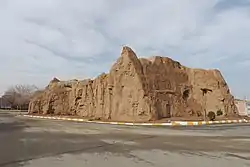 Kohneh Zendeh Jan Castle
Kohneh Zendeh Jan Castle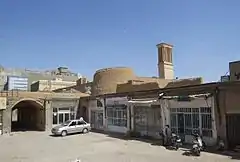 Amin al-tojar Caravansarai
Amin al-tojar Caravansarai Quzhd village
Quzhd village Grave of Pir Quzhd
Grave of Pir Quzhd Ghanat
Ghanat Watermill of Talaabad
Watermill of Talaabad Kashmar Enghelab sport complex
Kashmar Enghelab sport complex Kashmar Enghelab sport complex
Kashmar Enghelab sport complex Tree in Kudak park
Tree in Kudak park.JPG.webp) Azadegan Digital telephone center
Azadegan Digital telephone center Traffic police booth
Traffic police booth_(2).JPG.webp) Shohada' Square
Shohada' Square
References
- https://www.amar.org.ir/english
- Kashmar can be found at GEOnet Names Server, at this link, by opening the Advanced Search box, entering "-3069992" in the "Unique Feature Id" form, and clicking on "Search Database".
- "Census of the Islamic Republic of Iran, 1385 (2006)". Islamic Republic of Iran. Archived from the original (Excel) on 2011-11-11.
- "تاریخچه و نقشه جامع شهر کاشمر در ویکی آنا". ana.press. Retrieved 23 October 2020.
- "Kashmar". www.itto.org. Retrieved 11 October 2020.
- "ترشیز؛ دروازه ورود اسلام به خراسان". khorasan.iqna.ir. Retrieved 11 October 2020.
- "كاشمر شهر سروهاي افسانه اي". Mehr News Agency. Retrieved 11 October 2020.
- "The Destruction of Sacred Trees". www.goldenassay.com. Retrieved 6 February 2020.
- "The Cypress of Kashmar and Zoroaster". www.zoroastrian.org.uk. Retrieved 6 February 2020.
- کزازی، نامه باستان؛ ویرایش و گزارش شاهنامه فردوسی، ۶: ۴٧-۴۸.
- "دومین شهر زیارتی خراسان رضوی". khorasan.iqna.ir. Retrieved 6 February 2020.
- "گهواره های دانش در کاشمر، مهد پرورش نخبگان". Young Journalists Club. Retrieved 22 October 2020.
- "اداره میراث فرهنگی شهرستان کاشمر - سوغات کاشمر". kashmar.razavichto.ir. Retrieved 11 October 2020.
- Ford, P.R.J. (1989). The oriental carpet: a history and guide to traditional motifs, patterns, and symbols. Portland House. p. 163. ISBN 978-0-517-67224-2. Retrieved 25 June 2019.
The town of Kashmar in Khorassan province, between Meshed and Birjand, weaves carpets in a variety of styles and in a stitch which may also be described as intermediate between Meshed and Birjand. The design shown ...
- Bennett, I.; Aschenbrenner, E.; Parsons, R.D. (1981). Oriental Rugs: Persian. Oriental Rugs. Oriental Textile Press. p. 253. ISBN 978-0-907462-12-5. Retrieved 25 June 2019.
Kashmar lies at the edge of the great salt desert about 150 km (100 miles) south-west of Meshed. Under its earlier name of Turshiz its carpets had an indifferent reputation. The change of name occurred under the reign of ...
- Carpet Museum of Iran (2001). The indigenous elegance of Persian carpet: a collection from the Carpet Museum of Iran. Andishe Zand Pub. Co. p. 57. ISBN 9789649063034. Retrieved 25 June 2019.
- "Review of the Carpet Industry in Kashmar". www.jozan.net. Retrieved 10 December 2020.
- "Seyed Hassan Modares Tomb". en.shahrmajazi.com. Retrieved 31 July 2019.
- Tomb of Hassan Modares on site seeiran
- "Seyed Hassan Modares Tomb". www.itto.org. Retrieved 24 October 2020.
- "امامزاده سید مرتضی(ع)؛ نگین گردشگری مسافران نوروزی". International Quran News Agency. khorasan.iqna.ir. Retrieved 1 March 2020.
- "امامزاده سید مرتضی فرصتی برای گردشگری مذهبی در شهرستان کاشمر". www.dana.ir. Retrieved 10 December 2020.
- "Imamzadeh Hamzeh". Imamzadeh Hamzeh; Shelter of travelers to the sun. iqna. Retrieved 20 July 2019.
- "امام زاده سید حمزه کاشمر ،نگین فرهنگی منطقه". www.dana.ir. Retrieved 24 October 2020.
- "Kashmar information database". Archived from the original on 2013-12-03. Retrieved 2019-06-30.
- "مسجد جامع کاشمر؛ میراثی ماندگار با قدمتی بیش از دو قرن + عکس". khorasan.iqna.ir. Retrieved 10 December 2020.
- "خلیلآباد با قدمتی چند هزار ساله میزبان مسافران نوروزی". khorasan.iqna.ir. Retrieved 13 November 2020.
- "معرفی مسجدجامع خلیل آباد". salamabadi.ir. Retrieved 10 December 2020.
- "معرفی مسجد حاجي جلال شهرستان کاشمر". salamabadi.ir. Retrieved 26 October 2020.
- "قلعه کهنه زنده جان". seeiran.ir. Retrieved 26 October 2020.
- "Atashgah castle". www.itto.org. Retrieved 31 July 2019.
- "Irania Encyclopedia (Persian)". Irania Encyclopedia.
- "بقایای قلعه ریگ". www.kojaro.com. Retrieved 10 August 2019.
- "معرفی بقایای قلعه ریگ". salamabadi.ir. Retrieved 10 December 2020.
- "موقوفه امین التجار با بیش از یک قرن قدمت". www.qudsonline.ir. Retrieved 10 August 2019.
- "موقوفه «امین التجار»؛ نگین گردشگری در جنوب خراسانرضوی". Tasnim News Agency. Retrieved 10 December 2020.
- "Ali Abad Tower". www.itto.org. Retrieved 24 October 2020.
- Douglas Pickett: Early Persian tilework, The Medieval Flowering of Kashi, Fairleigh Dickinson University.. Press, 1997, ISBN 978-0-8386-3365-6, p.104
- "Firooz Abad Minaret". www.itto.org. Retrieved 24 October 2020.
- Douglas Pickett: Early Persian tilework, The Medieval Flowering of Kashi, Fairleigh Dickinson University. Press, 1997, ISBN 978-0-8386-3365-6, p.104
- "Namaq Village". www.itto.org. Retrieved 24 October 2020.
- "روستای تاریخی نامِق". khorasan.iqna.ir. Retrieved 24 October 2020.
- "Shahi Dam". IRIB NEWS AGENCY. Retrieved 25 October 2020.
- "Shahi Dam". Mizan Online News Agency. Retrieved 25 October 2020.
- "آبانبار سید باقر" [Seyed Bagher Ab anbar] (in Persian). Iran: دانشنامهٔ تاریخ معماری ایرانشهر. Archived from the original (PDF) on 22 August 2012. Retrieved 21 Aug 2012.
- "ب انبار سید باقر". seeiran.ir. Retrieved 13 November 2020.
- "معرفی برنامه قله باغدشت کاشمر". kavianclub.com. Retrieved 24 October 2020.
- "مدرسه حاج سلطان میراثی که در سکوت متولیان تخریب می شود/ قديمي ترين حوزه علميه کاشمر در آستانه نابودی". Mehr News Agency. Retrieved 24 October 2020.
- "مدرسه علمیه حاج سلطان العلماء". seeiran.ir. Retrieved 24 October 2020.
- "قلعه گبر حصار". seeiran.ir. Retrieved 13 November 2020.
- "معاون ناجا از فرودگاه سبک کاشمر بازدید کرد". Islamic Republic News Agency. Retrieved 13 October 2020.
- "Iran premier will quit". Schenectady Gazette. 2 April 1957. Retrieved 9 November 2012.
- "Iran premier will quit". Schenectady Gazette. 2 April 1957. Retrieved 9 November 2012.
- "Iran minister resigns post". Gettysburg Times. Tehran. 3 April 1957. Retrieved 9 November 2012.
- "Iran teachers' protest Iranian premier from office". The Press Courier. 5 May 1961. Retrieved 9 November 2012.
- "Centers of Power in Iran" (PDF). CIA. May 1972. Retrieved 5 August 2013.
- "Poeter fängslade". Aftonbladet. Archived from the original on 13 August 2015. Retrieved 18 October 2015.
- Sveriges Radio. "Ung persisk poesi gör motstånd". Archived from the original on 22 November 2015. Retrieved 18 October 2015.
- Kritiker, Medverkande, 2013, En motståndsrörelse på mitt skrivborg, page 185
- "Iranska poeter ska ha släppts". SVT. Archived from the original on 22 November 2015. Retrieved 18 October 2015.
- Shakhsiatnegar
- Cinetmag
- United Nation's press release
- Theodoulou, Michael (7 October 2008). "US economic crisis gives cheer in Tehran". The National. Archived from the original on 12 April 2011.
- "Tehran Stock Exchange names Ali Rahmani MD" (Press release). Tehran Stock Exchange. 2 January 2007. Archived from the original on 12 April 2011.
- Peterson, Scott; Faramarzi, Payam (2011). "Exclusive: Iran hijacked US drone, says Iranian engineer". csmonitor.com. Retrieved 15 December 2011.
- Mungin, Lateef (22 October 2013). "Iran claims released footage is from downed U.S. drone". CNN.
- "Obama says U.S. has asked Iran to return drone aircraft". CNN. CNN Wire Staff. 22 October 2013.
- The Preliminary Determination of Epicenters (PDE) Bulletin
- "اداره کل میراث فرهنگی گردشگری و صنایع دستی خراسان رضوی". kashmar.razavichto.ir. Retrieved 26 October 2020.
- "نگاهي به جاذبه هاي تاريخي و گردشگري كاشمر". Islamic Republic News Agency. Retrieved 26 October 2020.
- "Climate: Kashmar - Climate graph, Temperature graph, Climate table". Climate-Data.org. Retrieved 17 September 2013.
Sources
- Agheli, Bagher, Teymourtash Dar Sahneye-h Siasate-h Iran ("Teimurtash in the Political Arena of Iran") (Javeed: Tehran, 1371).
- Behnoud, Masoud, Een Se Zan, Ashraf Pahlavi, Mariam Firouz, va Iran Teymourtash
- Cronin, Stephanie, The Making of Modern Iran: State and Society Under Reza Shah (Routledge: London, 2003) ISBN 0-415-30284-6.
External links
| Wikimedia Commons has media related to Kashmar. |
| Wikivoyage has a travel guide for Kashmar. |
